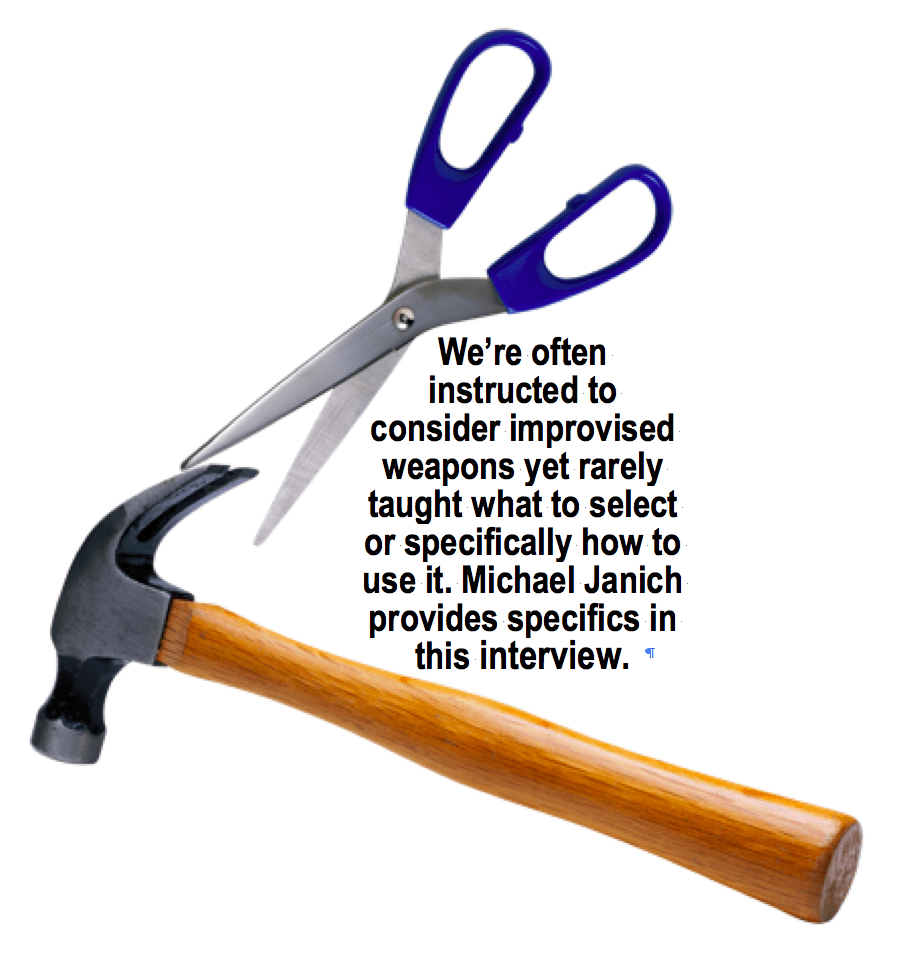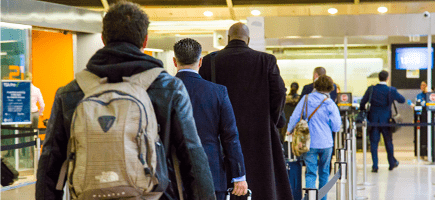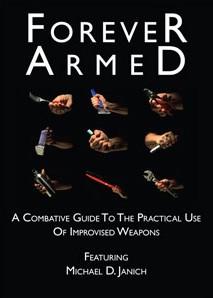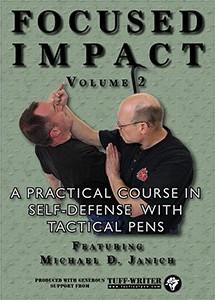
An Interview with Michael Janich
Interview by Gila Hayes
eJournal: Last month, in the Network’s online journal (http://armedcitizensnetwork.org/march-2016-surviving-an-active-shooter) we talked with you at length about strengthening our defense potential against armed terrorists. A number of times during that discussion, you spoke of defending yourself with whatever is at hand in a no-gun environment. From your long experience as a martial artist, can you outline principles for using improvised weapons to the greatest effect? Because our membership is firearms-focused, many of us may not have given sufficient consideration to improvising impact weapons, like the way you mentioned striking with a hammer, when you were outlining ways to make a classroom safer.
Janich: Whenever I’m asked about this topic, there is always one important thing I try to address first, and that is the mindset you want to achieve. When the media describes successful interventions in active shooter incidents, they typically do us a disservice by describing them in politically correct terms. For example, the U.S. service members who took down the shooter on the train in Belgium last summer. There, you had a situation where people took decisive action, but you often hear from the media things like, “Well, they tackled the shooter. They overpowered him.”
If you think in those terms, you are already thinking in the wrong mindset, because you are not trying to keep them from making a touchdown; you are trying to keep them from killing people. If you tackle somebody, what are you going to do once you tackle him? What you need to do is stop him from killing people, so you want to act as decisively and as ruthlessly as possible. Take him out of the fight!
If you look at stopping an active shooter in that context, it puts you in the right mindset to do what you need to do. To go back to the teacher analogy from last month, you have got all the kids hunkered down against the wall, you have the door barricaded and you have got the hammer in your hand. He manages to make it through the door. Here he comes! The first thing you see is his head coming through the door. Are you prepared to take that hammer and beat his head in? You should be. Be prepared to do what you have got to do.
We did a program on The Best Defense last season about a church active shooter (http://outdoorchannel.com/showepisodes.aspx?show-id=720). We showed using a pocketknife to disable an active shooter very quickly and very decisively. Some of the criticism we got from that was, “Are you really going to go after a guy armed with a rifle with a pocketknife?” Yes, because the pocketknife is something that I know I have with me all of the time. Obviously, a firearm would be better, but if that’s not possible, a purpose-designed weapon is still the preferred choice. I would rather choose my tools if I possibly could.
When you look at improvised weapons in an environment where you do not have any control over what is available, you are relying only on what is there. I’d rather stack the odds in my favor, like the example last month of the teacher with the fire extinguisher.
If we go back to the example of the pocketknife, the primary target in my Martial Blade Concepts system is the flexor tendons on the inside of the wrist, to take away whatever handheld weapons the attacker may have. Cut the tendons and the hand is crippled, so it can’t hold a weapon. Well, that also takes away trigger squeeze. If you have access to a knife and you have access to the shooter, the idea is targeting their ability to squeeze the trigger first, especially if you have a pocketknife. The idea that I will stab this guy until he stops shooting is a really inefficient way to address the problem.
There are a couple of places on the human body where you can stab somebody and get an immediate, profound stopping effect. They are really hard to hit in a stand-up fight. There are no guarantees you are going to hit them. If he has his hand gripping the gun and squeezing the trigger, you have much better access and it is very easy to simply hook it, rip and cut all the flexor tendons and take his hand out of the fight. If he can’t squeeze the trigger, he is no longer shooting the weapon unless he can switch it to the other hand, and you are already on top of that with the rest of your technique.
eJournal: This dovetails with the interview you gave us in early 2013, which readers can review at http://www.armedcitizensnetwork.org/images/stories/Network_2013-03.pdf. Is there more detailed instruction on this in the Martial Blade Concepts Distance Learning Program (http://www.martialbladeconcepts.com/training/mbc-distance-learning-program)?
Janich: Yes, the Distance Learning Program includes specific instruction about using a knife against an active shooter. That instruction has been very well received, especially by people in areas where carrying a firearm is not an option—like France.
I have been teaching in Paris for the past three years. Fred Perrin, a good friend of mine, a great martial artist, a custom knife maker and a very well known combatives trainer, has been kind enough to invite me there to teach seminars for his students, typically around Thanksgiving every year. It is a huge honor for me.
A lot of repeat students come back year after year. Most come from a martial arts background. There are some who are a bit more street-savvy and a bit more self-defense oriented, but many considered the training as an expression of the martial arts; they looked at it from the technical standpoint of an enthusiast. This past year, I was there about four days after the Paris terrorist attacks. The students’ attitudes were very different. In previous years, I’d show them a technique and they’d try it a couple of times, then stand around and socialize. This year, I could not get them to stop training.
I always try to meet the students’ needs as best as possible, so in the latter part of the seminar, I said, “Let me know if there is anything you would like me to address.” They said, “We know you do rifle disarms; can we do that?” This is France: not a very gun-centric culture at all. Most people are not shooters and have no interest. Owning a gun is very much an exception to the rule.
We were teaching at a traditional Japanese dojo with bokken, wooden swords, on the wall, so we pulled those off the wall and had people hold them as rifles. We had people learning how to take down people with rifles, using empty hands and using knives. It was interesting to see the mindset change. It was great, because it gave them some training that was relevant to something they were afraid of at the time.
eJournal: And even for us, who are customarily armed, the important thing that we must focus on is getting that rifle shut down, because even if we shoot him, the attacker may not die immediately. He can continue pulling the trigger.
Janich: Exactly. Look at the concept of stopping power. With a firearm, you are looking at basically shutting down the entire body, so you get your center of mass hits—ideally central nervous system hits—and shut down everything. It is like going to the fuse box and hitting the circuit breaker to turn off all the lights.
Stopping power with non-firearm weapons is a very different problem. If you have a less efficient weapon—an improvised weapon—you are not going to have a weapon that is efficient enough to turn off all the lights, so you have to look at shutting down the lights in just one room. Go to the wall, turn off the light switch in just this room.
How do I keep that shooter from shooting? Well, if I have a table leg, or I went into the utility closet and I pulled out a plunger or something like that, I can take his hand off of the gun. If I break his hand so that he can’t squeeze the trigger, that may be the first, best step to be able to stop him from killing people. I could hit this guy in the head repeatedly and not necessarily have the efficiency that I need to shut down the entire body, so he is still squeezing the trigger. Is the head the best target? Not necessarily, especially if you have a weapon that is not really as capable as you might like.
eJournal: Since interviewing you in 2013, I’ve thought of you as the Apostle of Targeting because I’ve never known anyone who teaches anatomy as integrally to physical, or non-gun, self defense as you do. I think your instruction in targeting for the immediately needed response is profound.
Janich: Well, thank you. Some years ago, the Department of Homeland Security put out a video, Run, Hide, Fight (see https://vimeo.com/73940709). When you watched the video, the Department of Homeland Security said you want to hide or run, but as a last resort, if you have to, you can fight. They then show somebody opening up a desk drawer, reaching in and grabbing a pair of scissors. The video continues happily on, but didn’t actually give anything as far as, “OK, I’ve got a pair of scissors in my hand, now what do I do?”
This came out back when Tactical Knives magazine was still around and I was writing the Street Smarts column for every issue, so I approached them and said, “Hey, I would like to do something to address this.” So we set it up to say, if you only had a pair of scissors and you had an active shooter armed with a shoulder weapon, what could you do?
We showed finding a place of hiding so you could ambush the shooter. When he goes past you, you spring out, come up from behind, grab him by the head, and pull his head back as you stomp the back of his knee. Once you bring him down to his knees, take the scissors and bury them through his eye into his brain. That’s about the only way that you are going to do anything with a pair of scissors that is going to make any difference. That was the missing element in the video’s “fight” part. You’ve got this notional way of saying, “You can fight. Here, grab a pair of scissors.” What was missing was the thought process, the commitment, and the violence of action to actually do anything worthwhile with scissors.
eJournal: Or to even ask, “Are the scissors even the best tool?”
Janich: Would you be better off grabbing something else? A huge part of the process is understanding what is a good improvised weapon and what is not. You have weapons of opportunity, and then you have improvised weapons that are weapons of plausible deniability.
eJournal: We are frequently told, “Be ready to use improvised weapons,” but we are never taught to realistically analyze what could and could not be accomplished with one item over another, nor does that advice ever go so far as to address what anatomical targets will yield the best outcome. You, on the other hand, once authored a video on improvised weapons, was it Always Armed?
Janich: It was Forever Armed, (http://www.staysafemedia.com/forever-armed.html) and basically it goes through the process of assessing objects and figuring out when you actually have a true weapon and when you don’t, as well as looking at how well you can wield the object based on its physical characteristics. Is it something you can hold as a fist load—that you can put in your fist to hit harder than you can with flesh and bone alone? Is it something that you can wield like a stick or a hammer? Is it something that is so big that you have to wield it with two hands? Is it a flexible object or is it a projectile? Can you wield it quickly enough? If you had that opportunity, hiding behind something when the active shooter goes by, can you, in a matter of two to three seconds, spring up and take decisive action?
One of the critics of the knife scenario that we did on The Best Defense said, “Well, if an active shooter is coming through I would just hit him with a chair.” Cool! What do we have here right now that we could hit somebody with? [gestures to several small sofas, a low, knee-height table that’s about four feet long, a flat screen TV mounted on an adjacent wall.]
The bigger the object, the harder it is to wield and the easier it is for the shooter to defend against it, either by getting out of the way or blocking it entirely. I would much rather have a knife like I carry on my body all the time. I know its capabilities. I train with it on a regular basis.
If you can’t carry a purpose-designed weapon, you need to think, “What can I carry that I can train with, use effectively as a weapon, and have with me all the time?” Maybe you have a flashlight. We worked with that several seasons ago on The Best Defense, in a scenario based on the theater shooting in Aurora, Colorado. We gave a lot of thought to it. Being from Colorado, it was something that was near and dear to our hearts and we didn’t want to be disrespectful, but at the same time we wanted to give people the best options they could have.
Think about a situation like that: everybody’s vision is dark-adapted. Pull out a tactical flashlight—200 lumens or better—and shine that in a shooter’s eyes. Now you’ve got something that you can carry with you all of the time that has great utility, makes a great impact weapon, and allows you to affect somebody at a distance.
Like a dry chemical fire extinguisher, which essentially is an improvised pepper spray, the flashlight is the same thing in a dark-adapted environment. The more ambient light, the less effective it is going to be, but still, if you have a bright flashlight to hit somebody in the eyes from a distance, you might buy a moment to take other decisive action. During that moment, somebody else might intervene or perhaps it lets you slip out the door and get away. If you have to use it as an impact weapon, you have something with which you can hit harder than you can with your hand alone.
eJournal: I like flashlights because you’re rarely challenged about why you carry it with you.
Janich: You may also travel, and that becomes an issue in and of itself. How do I change gears when I get on a plane? It’s always a sad moment as I wave goodbye to my checked baggage as my knives go away.
eJournal: Good example! Airports are another totally no-gun environment most of us end up in periodically. What do you do?
 Janich: You become even more vigilant. OK, I’ve gone through security and my options are now more limited, so I really start taking stock of what’s in my environment. I’m thinking, great, there is a ketchup bottle, it is glass, I could hit with that. I’ve got that [pointing at various objects on the table], I’ve got that, I’ve got that. You make it a game.
Janich: You become even more vigilant. OK, I’ve gone through security and my options are now more limited, so I really start taking stock of what’s in my environment. I’m thinking, great, there is a ketchup bottle, it is glass, I could hit with that. I’ve got that [pointing at various objects on the table], I’ve got that, I’ve got that. You make it a game.
I also need to be sure that I change gears. I always carry a knife in this pocket [right front pants pocket]. After going through security, what goes there? Well, the Tuff-Writer tactical pen moves to that pocket. I’ve always got a flashlight in the other pocket [the tool pocket of carpenter jeans], so I’ve got an impact weapon. For the tactical pen, the draw stroke that I would normally have for my knife now feeds the tactical pen in an underhand grip, while the flashlight still comes out in a reverse grip. All of my empty hand skills to “earn” my draw have lots of common ground—lots of commonality of technique—so I would still use those to bridge to a weapon if I couldn’t have it in hand in advance.
In everything we do, we try to have as much common ground as possible. Knife training, empty hand training, and stick training all have common ground, and much of that is based on surviving long enough to get to your weapon. For a shooter, it’s the same. We look at the realities of being attacked at close range and having to get your gun into the fight.
Many shooters fall short in their skills because they assume that they are going to have the reaction time to see the problem before it happens. If someone is at arm’s length and is going to stick a knife in my gut, I need to prioritize. If I think I am going to go for my gun first, I am going to get stuck. I have to focus on surviving the initial attack to be able to bring my gun into play.
That’s why we try to integrate everything we do. For our training drills on core techniques, you could ask, “Is it an empty hand technique? Is it an improvised weapon technique? Is it a knife technique?” Yes, it is all three. All we do is adapt to the attributes of the weapon. Am I hitting with my fist? Am I hitting with a Tuff-Writer pen (http://www.tuffwriter.com)? Am I cutting or stabbing with the knife? The mechanics are the same.
Even if you do carry a firearm or purpose-designed weapon, improvised weapons still offer excellent advantages. You can walk down the street with a pen in your hand and nobody is going to say anything. Walk down the street with a 1911 in your hands, and it is going to attract lots of the wrong kind of attention. With a pen in your hand, you are armed and have a significant head start if you are attacked. Your thought should then be, “How can I use this as a bridging weapon to get to my other weapons?”
The same applies to environmental weapons, but you must have the awareness and forethought to bring them into play. If I pick up a salt shaker because I have somebody trying to hit me in the head with a tire iron, I can deflect the attack, hit him with the salt shaker, and buy enough distance to draw a knife or a firearm. You must “earn” that draw by living through the initial attack long enough to bring a purpose-designed weapon into play.
Conversely, you may also flow back in the other direction. If you carry a five shot J-frame revolver you may find that you’ve shot five rounds and haven’t solved your problem yet. Now you’ve got a chunk of steel in your hand that makes a great impact weapon and is probably going to have more immediate effect than trying to fumble with a speed strip to get five rounds into your revolver. If the gun did not finish the job, now you are reverting, stepping backward. It becomes an impact weapon.
eJournal: How interesting to hear that progression in reverse!
Janich: When you look at this from the firearms perspective, we often hear the analogy, “To the man or woman who has only a hammer, everything looks like a nail.” That can be very limiting. However, when it comes to improvised weapons, it makes perfect sense. Look at the flip side of that mindset and say, what things do I do best? What is the best “hammer” I can have in a non-permissive environment?
For example, you might say, “If it comes down to it, I’m going to cover my head, and I’m going to kick this guy in the knee as hard as I possibly can. Or, I’m going to kick him in the shin, cripple him, and run.” That’s not a bad plan. Well, if I am going to be flying on an airplane and don’t have all my normal toys at my disposal, I should think about ways to make that plan better. Can I kick harder with boots like these [gestures toward ankle-high lace up boots] than I can with tennis shoes? Yep. Well, my boots just became an improvised weapon.
eJournal: So you’re not going to wear flip-flops because they won’t support a hard kick.
Janich: Right! And if you have to run, flip-flops aren’t a great choice, either. If you wear ankle-high shoes, you’re not going to step on your own shoe and have it come off either. If your shoe is laced up around your ankle, it is going to stay on your foot.
Basically, try to game the system as much as you can and focus on the things you do best. Ask yourself, “What techniques am I really good at? What do I have confidence in? How can I make the best use of those?” If you say, “You know what? I can punch really hard.” OK, great. But unless you’ve actually toughened your knuckles and trained to punch without any kind of support, you can break your hand. The last thing you want to do is break your hand, then try to access a weapon. So instead you need to ask yourself, “What can I do to make my punches better?”
You can get on an airplane with a carabineer; I’ve done it many times. Take that carabineer and put it in your palm, with the other portion sticking out so that the long portion is in line with your forearm. With it braced against your palm, you now have great improvised brass knuckles. Now you can punch like crazy, hit really hard, and cause real damage without hurting your own hand.
Figure out what are your go-to things, what do you really have confidence in, and then structure your approach to self defense around those things. That gives you confidence in what you do. You don’t want to be a one-trick pony, but at the same time, you don’t want to have to learn a thousand different techniques. I want to be really good at something that becomes a go-to technique that I have confidence in that I can amplify if possible. If I kick really well, let me put on some kick-ass shoes that are going to amplify the effects of what I do.
eJournal: This is a valuable line of thinking, because it breaks us away from excessive focus on one weapon, which for most of us is going to be an everyday carry gun. It opens up our defensive capabilities, not only into what around us that can be improvised, but more importantly, what we can carry along, even in restricted areas, that we have trained up on and know how to use in self defense.
Thank you so much for all this great instruction! How can we learn more?
 Janich: If you like the logic of what we discussed here, I strongly recommend you take a look at my instructional videos on improvised weapons. Forever Armed (http://www.staysafemedia.com/forever-armed.html) is an overview of all types of improvised weapons, their advantages and disadvantages, and some simple tactics for using them effectively. If you like the idea of staying constantly armed with a tactical pen or a flashlight, I recommend my Focused Impact series (http://www.staysafemedia.com/focused-impact-volume-1.html and http://www.staysafemedia.com/focused-impact-volume-2.html).
Janich: If you like the logic of what we discussed here, I strongly recommend you take a look at my instructional videos on improvised weapons. Forever Armed (http://www.staysafemedia.com/forever-armed.html) is an overview of all types of improvised weapons, their advantages and disadvantages, and some simple tactics for using them effectively. If you like the idea of staying constantly armed with a tactical pen or a flashlight, I recommend my Focused Impact series (http://www.staysafemedia.com/focused-impact-volume-1.html and http://www.staysafemedia.com/focused-impact-volume-2.html).
 It’s a two-volume series that presents step-by-step instruction in a simple, but extremely versatile, system of self defense based around the use of tactical pens; however, the same skills easily translate to flashlights, Kubotans, and similar objects.
It’s a two-volume series that presents step-by-step instruction in a simple, but extremely versatile, system of self defense based around the use of tactical pens; however, the same skills easily translate to flashlights, Kubotans, and similar objects.
 If you’re really serious, my Distance Learning Program, or DLP, is the ultimate training resource for my approach to self defense. It is an online program that currently includes more than 20 hours of step-by-step instructional videos on all aspects of personal defense.
If you’re really serious, my Distance Learning Program, or DLP, is the ultimate training resource for my approach to self defense. It is an online program that currently includes more than 20 hours of step-by-step instructional videos on all aspects of personal defense.
We shoot these up close and with extreme detail, so each video is the next-best thing to private training with me. The DLP is available as an annual subscription (https://shop.platformpurple.com/product/?shop=1909&product=27943) with lots of extra benefits or as a monthly subscription (https://shop.platformpurple.com/product/?shop=1909&product=40763). Both subscriptions allow you access to my closed Internet forum and allow subscribers to request the production of videos on specific topics. In that way, it’s always evolving and very interactive. On average, we add about 60-90 minutes of new content every month.
And, of course, keep watching The Best Defense on Outdoor Channel.
Thank you very much for the opportunity to share my thoughts with the ACLDN community!
__________

Michael Janich has been studying and teaching self-defense and the martial arts for more than 35 years. He has earned instructor’s credentials in an array of styles, and is also one of the foremost modern authorities on handgun point shooting, being one of the few contemporary instructors to have been personally trained by the late close-combat legend Colonel Rex Applegate.
Janich served nine years in the U.S. Army Intelligence and Security Command, including a three-year tour at the National Security Agency. In addition to authoring six books and coauthoring seven books and more than 20 videos, Janich has been published in more than a dozen magazines and newsletters.
Michael, through his company Martial Blade Concepts, holds seminars across the country. To learn more about these seminars, please consult his website, http://www.martialbladeconcepts.com/training/michael-janich-seminar-schedule. Of course, Marty and Gila would love to spend the weekend with you at the Firearms Academy of Seattle, Inc. when we host Michael’s two-day training course the second weekend in June. Read more at http://firearmsacademy.com/guest-instructors/112-martial-blade-concepts-critical-skills-of-self-defense-with-knives.
Click here to return to April 2016 Journal to read more.
